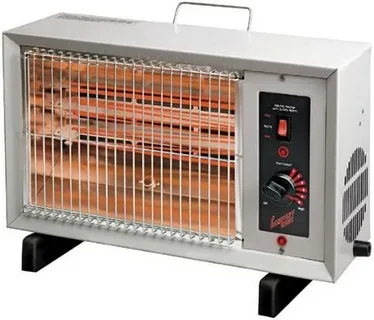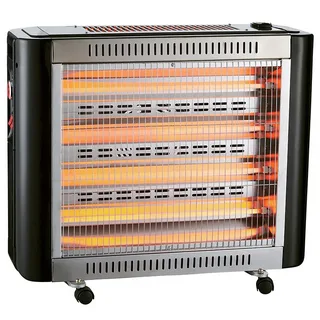Are you tired of dealing with cold spots in your home during the winter months? Electric radiant heater might be the solution you’ve been looking for. These innovative heating systems offer efficient, consistent warmth while helping you save on energy costs. In this blog post, we will explore the many advantages of using electric radiant heaters in your home, from their functionality to energy-saving tips and cost comparisons with traditional heating systems.
What Are Electric Radiant Heaters and How Do They Work?
Electric radiant heaters operate on a principle distinct from conventional heating systems, focusing on direct heat transfer to objects and individuals within a space. This heating method is inherently more efficient than its forced-air counterparts, primarily because it circumvents the heat loss associated with air ducts and unintended leakage. A heating element often crafted from robust materials like ceramic is at the heart of an electric heater. This element is enveloped within a reflective casing designed to focus and project heat outward into the room.
The underlying mechanism of electric radiant heating is simple yet effective. When activated, the heating element rapidly warms up, and thanks to the reflective surface surrounding it, this generated warmth is directed away from the heater. Instead of warming the air, the heat radiates outwards, targeting the people and objects in its path. This direct line of warmth ensures that energy is utilised most efficiently, reducing the time and power needed to achieve a comfortable room temperature.
This method contrasts starkly with traditional heating solutions, which primarily work by increasing the air temperature within a space. By heating objects and individuals directly, electric radiant heaters provide a swift, targeted heating solution that is both effective and economical. This operational efficiency contributes to a more comfortable living environment and aligns with energy-saving objectives, offering a sustainable alternative to conventional heating methods.
 The Top Benefits of Installing Electric Radiant Heaters
The Top Benefits of Installing Electric Radiant Heaters
One of the most notable advantages of electric radiant heaters is their capacity to offer immediate and consistent heating. This quality is particularly beneficial in rooms that see sporadic use or areas within homes that require quick heating solutions, like bathrooms and small workspaces. In these situations, the swift delivery of heat ensures comfort is quickly achieved without the long wait associated with traditional heating systems.
Another key benefit of electric radiant heaters is their superior energy efficiency. Unlike conventional heaters that warm the air, electric radiant heaters directly heat objects and people in a room. This direct heating method means that the heaters can operate at lower temperatures yet still provide comfortable warmth.
The efficiency of this process results in noticeable reductions in energy usage, making these heaters an eco-friendly choice. Over time, the savings on energy bills can be significant, highlighting the cost-effectiveness of electric radiant heaters compared to standard heating options that cycle on and off, struggling to maintain a consistent air temperature.
Electric radiant heaters also stand out due to their incredible versatility. They can be installed in various settings, including underfloor heating, which offers an even distribution of warmth across the floor surface, and as infrared heaters or ceiling panels for targeted warmth. This adaptability ensures that each home part can be effectively and efficiently warmed, enhancing overall comfort. Additionally, this installation flexibility allows for a cleaner aesthetic in the house, as the heating systems can be incorporated without the need for bulky equipment that can disrupt the interior design.
The combined benefits of immediate, efficient heating, reduced energy consumption, and versatile installation options make electric radiant heaters appealing to homeowners. These heaters provide an effective way to improve a living space’s warmth and comfort whilst offering the potential for significant energy savings. Their design and operational efficiency support a more sustainable lifestyle, aligning with the priorities of environmentally conscious individuals.
Exploring the Different Types of Electric Radiant Heaters
Electric radiant heaters encompass a variety of models, each tailored to specific needs and preferences. These include:
Infrared Radiant Heaters
These heaters use infrared technology to directly warm people and objects without heating the air first. Ideal for outdoor spaces or poorly insulated areas, they provide immediate warmth, making them perfect for patios or any space requiring quick heat delivery.
Radiant Ceiling Panels
Mounted on the ceiling, these panels emit warmth downwards, creating a comfortable environment without the bulkiness of conventional heaters. They’re particularly suitable for rooms where space is at a premium, offering a discreet heating solution that distributes heat evenly throughout the space.
Radiant Floor Heating Systems
Hidden beneath the floor, this heating type delivers warmth from the ground up, ensuring a cosier feeling underfoot. It’s an excellent choice for new construction or during major renovations and is highly regarded for its uniform heat distribution across any room.
Each system has distinct advantages, from the targeted warmth of infrared heaters to the subtle, evenly distributed heat of floor systems. Selecting the right type depends on several factors, including the space’s specific requirements, installation possibilities, and personal comfort preferences. Regardless of the choice, each variant presents an efficient way to heat your home, enhancing comfort without compromising aesthetics or space.
Installation and Maintenance of Your Electric Radiant Heater
Embarking on installing an electric radiant heater can be a straightforward endeavour, primarily if approached with due diligence and, when necessary, professional assistance. The process generally requires affixing the heater to a chosen wall or ceiling position, establishing a secure connection to the property’s electrical system, and fine-tuning the device to align with your comfort preferences. For those less inclined towards DIY projects, engaging a qualified electrician to oversee the installation ensures compliance with safety standards and optimises the heater’s performance.
Once installed, the upkeep associated with electric radiant heaters is notably low-key, reflecting the systems’ design for longevity and hassle-free operation. Regular dusting and the occasional inspection of electrical connections suffice to maintain optimal functionality. It is prudent to consult the manufacturer’s guidelines to comprehend the specific maintenance recommendations for your chosen model.
Furthermore, should any part of the heater exhibit wear or damage, seeking immediate professional advice will safeguard against efficiency losses and extend the unit’s service life. Adhering to these straightforward practices ensures that your electric heater remains a reliable and efficient source of warmth, contributing to your home’s comfort and energy efficiency.
Energy-Saving Tips for Electric Radiant Heating
Several strategies can be implemented to enhance the efficiency of your electric radiant heating and further reduce your energy consumption. Firstly, integrating a programmable thermostat into your heating system allows for meticulous control over the temperature, enabling you to adjust settings by your daily routine and thereby avoid unnecessary heating. Significant energy savings can be realised by setting the thermostat to lower temperatures when the house is empty or everyone is asleep.
Ensuring that your home is well insulated is crucial in maximising the effectiveness of electric radiant heaters. Proper insulation retains heat more effectively and minimises the energy required to maintain a comfortable temperature, leading to lower heating costs. Additionally, the strategic use of curtains or blinds to cover windows during colder periods can act as an additional layer of insulation, preventing heat from escaping and reducing the demand on your heating system.
Another practical tip is to keep doors and windows firmly closed to prevent draughts, which can lead to heat loss. For rooms that benefit from natural sunlight during the day, opening curtains or blinds to allow the sunlight to warm the space naturally can reduce reliance on artificial heating.
Consider deploying ceiling fans set on a low speed in reverse mode to circulate warm air more evenly throughout the room and ensure that heat is distributed uniformly and efficiently.
By adopting these straightforward yet effective measures, you can optimise the performance of your electric radiant heaters, contributing to both enhanced comfort and more significant energy savings in your home.
Cost Analysis: Electric Radiant Heaters vs. Traditional Heating Systems
The immediate outlay required for fitting an electric heater might appear substantial when set beside traditional heating solutions. Nevertheless, a deeper financial analysis reveals that, over time, electric radiant heaters stand as the more economical option, particularly when considering the day-to-day running and maintenance costs.
Unlike conventional systems that warm up the air and circulate it, which can be highly inefficient as this often warms spaces not in use and suffers from heat dissipation through ventilation ducts, radiant heaters focus directly on heating the people and objects in a room. This method ensures that no heat is squandered and contributes to a reduction in energy use. This specificity in heating can significantly decrease operational times and intensity, thereby lessening electricity expenditures in the longer term.
Moreover, these heaters’ robustness and low maintenance demands mean that the frequency and costs of repairs or replacements are substantially reduced. Evaluating both systems on these parameters illuminates the long-term cost savings brought by electric radiant heaters, making them an economically astute option that compensates for the initial higher installation cost with sustained savings and more excellent environmental benefits.
Conclusion
Electric radiant heaters present a compelling case for those seeking to enhance their domestic heating system, emphasising efficiency and cost-effectiveness. By offering targeted warmth that translates to immediate comfort and reducing energy consumption, these heating solutions stand out as a forward-thinking choice for modern homes. The adaptability of these systems, capable of being integrated into various living spaces without infringing on aesthetics or functionality, further underscores their appeal. Embracing this technology elevates the comfort and warmth of your home and aligns with the broader objectives of energy conservation and environmental stewardship.
FAQs
Is it safe to operate electric radiant heaters within the home?
Provided they are correctly installed and regularly maintained. Modern electric radiant heaters have various safety features, including automatic shut-off mechanisms to prevent overheating.
Can these heaters be installed in rooms with high humidity, such as bathrooms?
Indeed, several models are specifically designed to cope with the high moisture levels typical of bathrooms and similar environments. It’s crucial, however, to ensure that the chosen model is suitable for such conditions to prevent any potential safety hazards.
What lifespan can be expected from electric radiant heaters?
Electric radiant heaters can last 20 years or more when maintained according to the manufacturer’s recommendations. Their longevity is one of the many advantages, ensuring they provide a cost-effective solution.
How do electric radiant heaters deliver warmth?
They work by emitting infrared radiation that directly heats objects and people in a room. This method is more direct and efficient than traditional systems that heat the air. This process results in quicker warmth and can lead to energy savings.
What variety of electric radiant heaters is available?
Options range from infrared heaters, ideal for spot heating and outdoor areas, to radiant ceiling panels and underfloor heating systems, which offer a more distributed and discreet heating solution. The choice largely depends on your specific heating needs and installation possibilities.
| Other Good Articles to Read |
| niche blogs connect |
| blogs 97 |
| Blog Stitution |
| blogs unplugged |
| blogs cotch rouge |
| blog signatr |
| blog sintonias |
| blog zilla |
| consumer forums |
| finance forums |
| g blogs |
| too blog |
| Related Business Listings |
| Contact Directory |
| Local Business Profiles |



